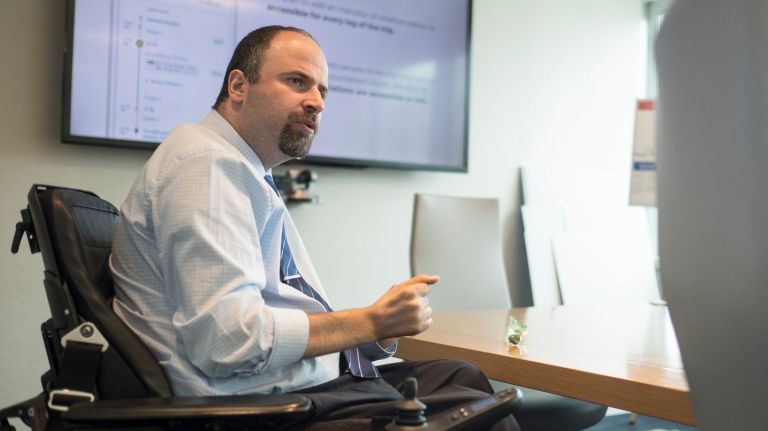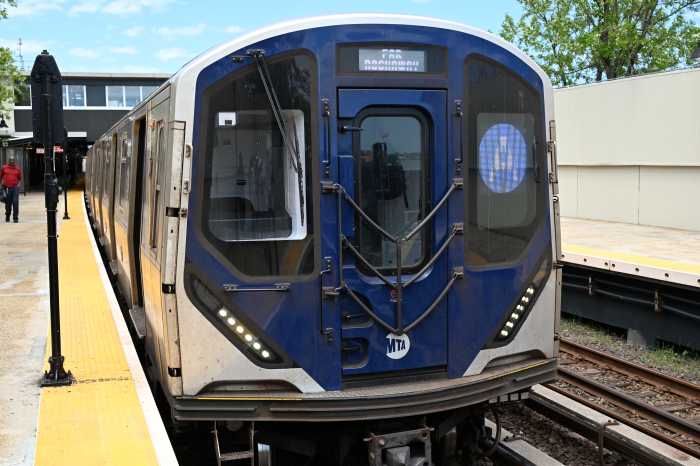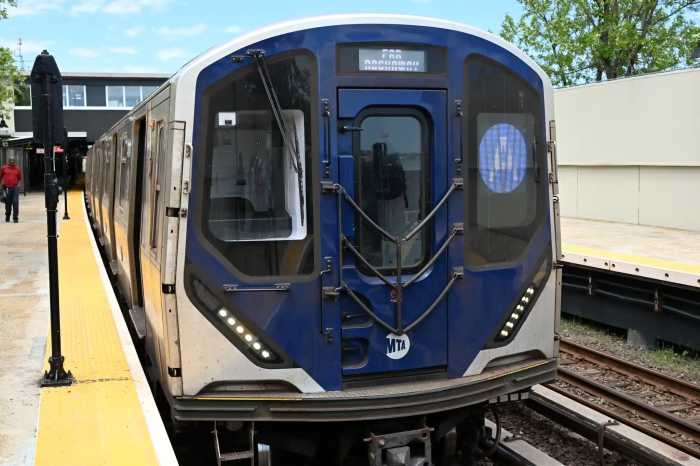
Alex Elegudin is a busy man.
The first-ever accessibility chief at New York City Transit has logged long hours as he carves out his new position in the mountain of bureaucracy that is the MTA. As the authority simultaneously grapples with ridership declines on slow buses and unreliable trains, Elegudin is tasked with an important challenge: improving the inaccessible subway system as well as the paratransit service for the nearly two million residents who are seniors, small children or living with a disabilities.
“I have meetings or engagements 9 a.m. to 5 [p.m.] and I spend 5 to 9 answering my emails, writing things, ” said Elegudin in his still sparsely decorated office, just about a month into his new job.
Elegudin commutes to his office in 2 Broadway from Coney Island via express bus or car and has used a wheelchair since a 2003 car accident with a deer while he was a college undergrad. He wants his perspective as a wheelchair user to seep into the culture at NYC Transit in a cohesive, unified way.
“I do believe that everybody understands why this position is necessary,” he continued. “There are many different units doing a little bit of accessibility. It would take one person in the place where I’m at to bring all those efforts together to be successful.”
Twenty-eight years after the Americans with Disabilities Act, only about 24 percent of the MTA’s 472 subway stations are wheelchair accessible — and the MTA struggles to keep even those station elevators in working order. Other century-old systems, albeit with fewer total stations, fare better. About 71 percent of Boston’s subway stations and 69 percent of Chicago’s rail stations have been made accessible.
Elegudin’s boss, NYC Transit president Andy Byford, released his Fast Forward plan this spring outlining the agency’s still-unfunded blueprint for modernizing service. A section in the plan was dedicated to improving accessibility, committing to ADA access at 50 additional stations within 5 years. The plan identified stations with the idea that riders are never more than two stops from an accessible station. If funded, Byford said the MTA could reach a state of near full accessibility by 2034.
“As an advocate from the community, which is what I was and still am to some degree . . . I think the goal and the journey is one station at a time until we get them all done,” Elegudin said, when asked if he believes the MTA can achieve a completely accessible subway system. “So when we get to 95 percent accessibility, or 75 percent accessibility, we’ll see what’s remaining. For now we’re gong to tackle the ones that are feasible, the ones that the community believes should go next. I don’t think there’s a reason, at least right now, to look at the last most challenging station before we’ve done all the ones that we can do.”
Elegudin, an attorney, joined the Taxi & Limousine Commission in 2015 as its accessibility program manager. He also co-founded the nonprofit group Wheeling Forward to advocate for people with disabilities. Jessica Murray, an advocate from the Elevator Action Group of Rise and Resist, said she felt Elegudin was a “good pick” for the job, but stressed that the MTA’s problems cannot simply be solved by installing new elevators.
“I think most people are really familiar with the elevator issues,” Murray said. “Those issues also need money to fix and we don’t know when that money is going to come. In the meantime, there are a lot of other accessibility issues that need to be highlighted and that includes other disabilities that we kind of forget about — people with hearing loss, blindness or low vision.”
Elegudin seems to be aware of those challenges. He’s looking into how to reduce subway platform gaps and is interested in redesigning subway maps for the disabled community, including braille maps, large-print maps and maps that are designed to more predominantly or exclusively highlight accessible stations. He’s also interested in hiring a few staffers for his team to cut down on his long workdays.
During the deluge of internal meetings, which Elegudin said take up 60 or 70 percent of his time, he’s hashing out strategies and projects that he refers to as “quick wins” — cheap and easy improvements that could be done while the agency tackles the larger, more complicated task of elevator installations. These quick wins include Transit-wide ADA sensitivity training; improved real-time communications; and better community outreach, perhaps through a new advisory committee on accessibility.
Elegudin will also have to address Transit’s exceedingly popular, yet costly, paratransit e-hail pilot, which launched as a one-year service option last fall for a small pool of 1,200 Access-A-Ride users. While Access-A-Ride requires riders to book trips a day in advance, pilot users can hail a yellow or green taxi any time through an e-hail app for a ride priced at $2.75.
The service costs the MTA $35.91 per trip — still cheaper than Access-A-Ride’s $68.71 per-trip cost. But riders loved the e-hails so much that the MTA widely underestimated how many trips would be completed. The authority has had to allocate millions more to the program, which is expected to cost the agency more than $60 million in the first year.
“We want to get to a place where we’re utilizing taxis much more in general — not just for riding some on-demand flexibility option, but making it part of the system. But right now taxis don’t have the capacity,” Elegudin said. “Taxis aren’t always able to fulfill the trips . . . But I think some nice distribution with trips through taxis, primary vehicles, other modes and brokerage hopefully will get us a to a nice medium.”
During a meeting with TransitCenter advocacy associate Colin Wright on a recent Tuesday morning, Wright said Elegudin has “been very open to meeting with the community. He’s been quite frank with his role and the challenges at hand.”
“The way I think that Alex and Andy have engaged with the accessibility community . . . I think it really does show that there is sort of a page turning here at New York City Transit,” Wright said.
After Tuesday’s meeting, Elegudin went down to the Bowling Green subway station to examine a new project. The MTA will be adding signage to elevators at platforms in the busiest stations that direct wheelchair users on how to get above ground in the case of an outage — a daunting and sometimes scary task without any information, Elegudin acknowledged.
But the elevator’s design blocked what would have been the appropriate location to hang the sign — at minimum 48 inches from the floor, according to ADA requirements. Elegudin guided the worker to hang the sign at a lower level that was still legible to him.
“There’s always an ideal goal . . . but, again, in the subway system, like many things, we’re going to do the best that we can,” Elegudin said. “Being a wheelchair user myself, I have the perspective to be able to say, ‘Well, it doesn’t mean we can’t do it. It just means that we do it this way.’”




































